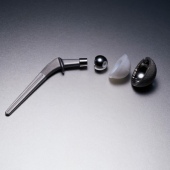
TUESDAY, April 19 (HealthDay News) — People who have hip replacement surgery now spend far shorter recovery time in hospital than they did almost two decades ago, but discharges to nursing facilities and readmissions to hospitals have soared as a result, Iowa researchers report.
Using Medicare data on more than 1 million hip surgeries done between 1991 and 2008, the researchers found that hospital stays are now averaging under four days, compared to more than nine days in the 20th century. However, the number of hip-surgery patients discharged to a skilled nursing facility nearly doubled during that time frame, from 17.8 percent to 34.3 percent; hospital readmission rates went from 5.9 percent to 8.5 percent; and the percentage of those discharged home decreased dramatically, from 68 percent to 48.2 percent.
“Both primary and revision hip arthroplasty are safe and mortality is low, but hospital stays are [now] extremely short. And, as patients’ length of stays go down, there’s less time to recuperate, and even if they’re not yet ready to go home, they have to go somewhere else quickly, and more are being admitted to rehabilitation centers,” explained the study’s lead author, Dr. Peter Cram, an associate professor in the division of general internal medicine at the University of Iowa Carver College of Medicine in Iowa City.
“This is part of what’s so complicated in the political discussions on healthcare,” he added. “You’re really just squeezing a balloon here. If we reduce the length of stay in the hospital, we can save money, or at least it seems like a way to save money. But, when we squeeze the balloon on one end to reduce length of stay, other costs pop up on the other side of the balloon.”
Pointing to the increased hospital readmissions and discharges to nursing homes, he said, “This is why it’s so hard to reduce or contain healthcare costs.”
Results of the study are published in the April 20 issue of the Journal of the American Medical Association.
Each year, about 280,000 Americans undergo hip replacement surgery, at a cost of more than $12 billion, according to background information in the study.
In the current study, Cram and his colleagues reviewed Medicare Part A data on over 1,450,000 total hip arthroplasty procedures (hip replacement surgery) and almost 349,000 revision hip arthroplasties (artificial hip repair surgery) done between 1991 and 2008.
The average age of people undergoing hip replacement rose slightly from 74.1 to 75.1 over the study period. The age of those having revision surgery went up even more, from 75.8 years old to 77.3.
The number of other medical conditions that those undergoing total hip replacement surgery had increased from an average of one to an average of two between the 1990s and 2008. For those undergoing hip repair, the number of other illnesses went from 1.1 to 2.3 during the study period.
The study did have some good news, however: in-hospital mortality rates after total hip replacement fell from 0.5 to 0.2 percent over the study period, while the 30-day post-op mortality rate fell from 0.7 to 0.4 percent.
Still, the upsurge in post-replacement nursing home care and hospital readmissions is worrisome and expensive, one expert said.
“This trend added significant additional costs back into the system,” noted Dr. Joseph Zuckerman, chairman of the department of orthopaedic surgery at the NYU Hospital for Joint Diseases and the NYU Langone Medical Center in New York City.
And he added, “Of greater concern is the fact that, at the same time discharges to skilled nursing facilities were increasing, so did the readmission rate for hip arthroplasty — increasing from 5.9 to 8.5 percent, adding not only additional costs, but raising concerns about the quality of care provided.”
More information
The American Academy of Orthopaedic Surgeons has advice on preparing for joint replacement surgery.

